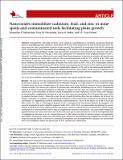| dc.contributor.author | Indraratne, Srimathie P. | |
| dc.contributor.author | Pierzynski, Gary M. | |
| dc.contributor.author | Baker, Lucas R. | |
| dc.contributor.author | Prasad, P.V. Vara | |
| dc.date.accessioned | 2023-02-14T19:19:53Z | |
| dc.date.available | 2023-02-14T19:19:53Z | |
| dc.date.issued | 2021-04-26 | |
| dc.identifier.citation | Indraratne, Srimathie P., Gary M. Pierzynski, Lucas R. Baker, and P.V. Vara Prasad. “Nano-oxides immobilize cadmium, lead, and zinc in mine spoils and contaminated soils facilitating plant growth.” Canadian Journal of Soil Science 101 (2021): 543–554 (2021). DOI: dx.doi.org/10.1139/cjss-2020-0127. | en_US |
| dc.identifier.issn | 0008-4271 | |
| dc.identifier.uri | https://hdl.handle.net/10680/2035 | |
| dc.description.abstract | Nanoparticles with high reactivity can be applied as amendments to remediate soil metal contaminations by immobilizing toxic elements. Nano-oxides of Fe have been studied but Al and Ti nano-oxides have not been tested for their remediation capacity of toxic metals. The potential of synthesized iron (Fe-O), aluminum (Al-O), and titanium (Ti-O) nano-oxides for stabilizing Cd, Pb, and Zn in mine spoil (Chat) and contaminated soil was compared using adsorption studies and a greenhouse experiment. Chat and soil were amended with nanooxides at two rates (25 and 50 g·kg−1) and a pot experiment was conducted with sorghum (Sorghum bicolor L. Moench). Leachates were collected twice per week from plant emergence to harvest at maturity and metals were compared against an unamended control. Chat was contaminated with Cd, Pb, and Zn at 84, 1583, and 6154 mg·kg−1, and soil at 15, 1260, and 3082 mg·kg−1, respectively. Adsorption conformed to the Langmuir linear isotherm and adsorption maxima of metals were in the order of Al-O > Ti-O ≥ Fe-O. Nano-oxides reduced Cd concentration by 28% (Fe-O) to 87% (Ti-O) and Zn concentration by 14% (Fe-O) to 85% (Al-O) in plant tissues compared with unamended Chat. Nano-oxides significantly reduced Cd, Pb, and Zn in leachates and available Cd and Zn in Chat/soil relative to the respective unamended controls. Nano-oxides can be used to remediate heavy metal contaminated Chat and soil and facilitate plant growth under proper nutrient supplements. Nano-oxides of Al-O and Ti-O remediated metals more effectively than Fe-O. | en_US |
| dc.description.sponsorship | "We thank the Department of Agronomy at Kansas State University for providing the facilities and materials to conduct this research. Contribution No. 21-074-J from Kansas Agricultural Experiment Station. The first author received the Fulbright Visiting Scholar Fellowship and wishes to acknowledge the CIES, USA Fulbright Program for funding the visit to KSU." | en_US |
| dc.description.uri | https://cdnsciencepub.com/doi/10.1139/cjss-2020-0127 | en_US |
| dc.language.iso | en | en_US |
| dc.publisher | NRC Research Press | en_US |
| dc.rights | info:eu-repo/semantics/openAccess | en_US |
| dc.subject | Bioavailability | en_US |
| dc.subject | Immobilization | en_US |
| dc.subject | Heavy metals | en_US |
| dc.subject | Mine spoils | en_US |
| dc.subject | Nanoscale oxides | en_US |
| dc.title | Nano-oxides immobilize cadmium, lead, and zinc in mine spoils and contaminated soils facilitating plant growth | en_US |
| dc.type | Article | en_US |
| dc.rights.license | Creative Commons Attribution 4.0 International License (CC BY 4.0) | en_US |
| dc.identifier.doi | 10.1139/cjss-2020-0127 | en_US |

